Taxation Law Assignment: Income Tax and Capital Gains Analysis
VerifiedAdded on 2021/05/31
|6
|1637
|46
Homework Assignment
AI Summary
This taxation law assignment solution provides detailed answers to ten questions covering various aspects of Australian income tax law. The solution addresses key concepts such as deductible expenses under s. 8(1) of the ITAA 1997, distinguishing between capital and revenue expenditure, and the application of the Hallstroms principle. It analyzes the cost base calculation for capital assets, including the impact of repair expenses and incidental costs. The assignment also explores depreciation methods (prime cost vs. diminishing value), the main residence exemption under Division 118-B, and the tax treatment of capital gains and losses, including the 50% discount for long-term capital gains. The solution also considers specific scenarios like home office deductions, and the tax implications of insurance compensation, trade restraint clauses and pre-CGT assets. The solution refers to relevant sections of the ITAA 1997 and ATO rulings to support the analysis.
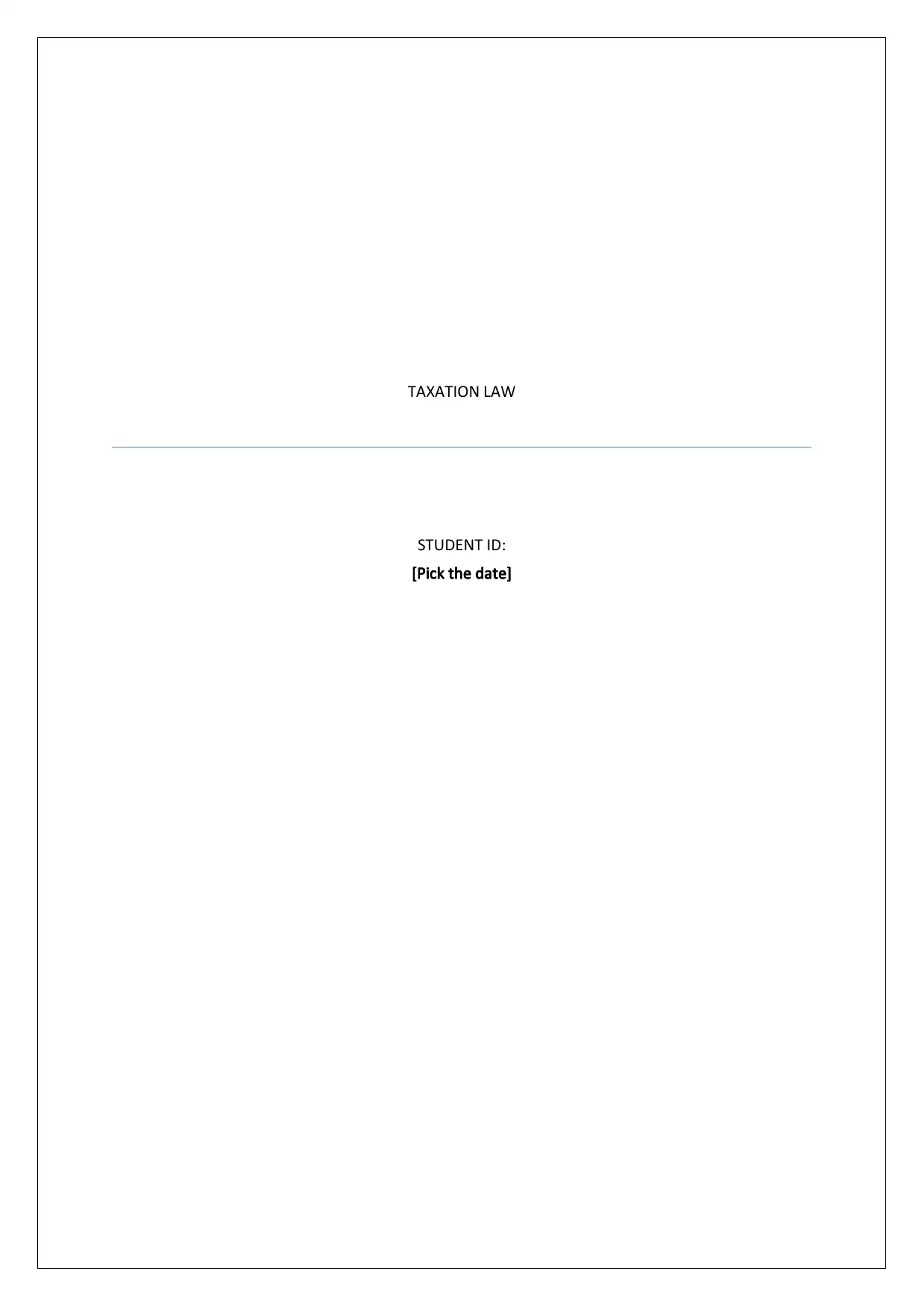
TAXATION LAW
STUDENT ID:
[Pick the date]
STUDENT ID:
[Pick the date]
Paraphrase This Document
Need a fresh take? Get an instant paraphrase of this document with our AI Paraphraser
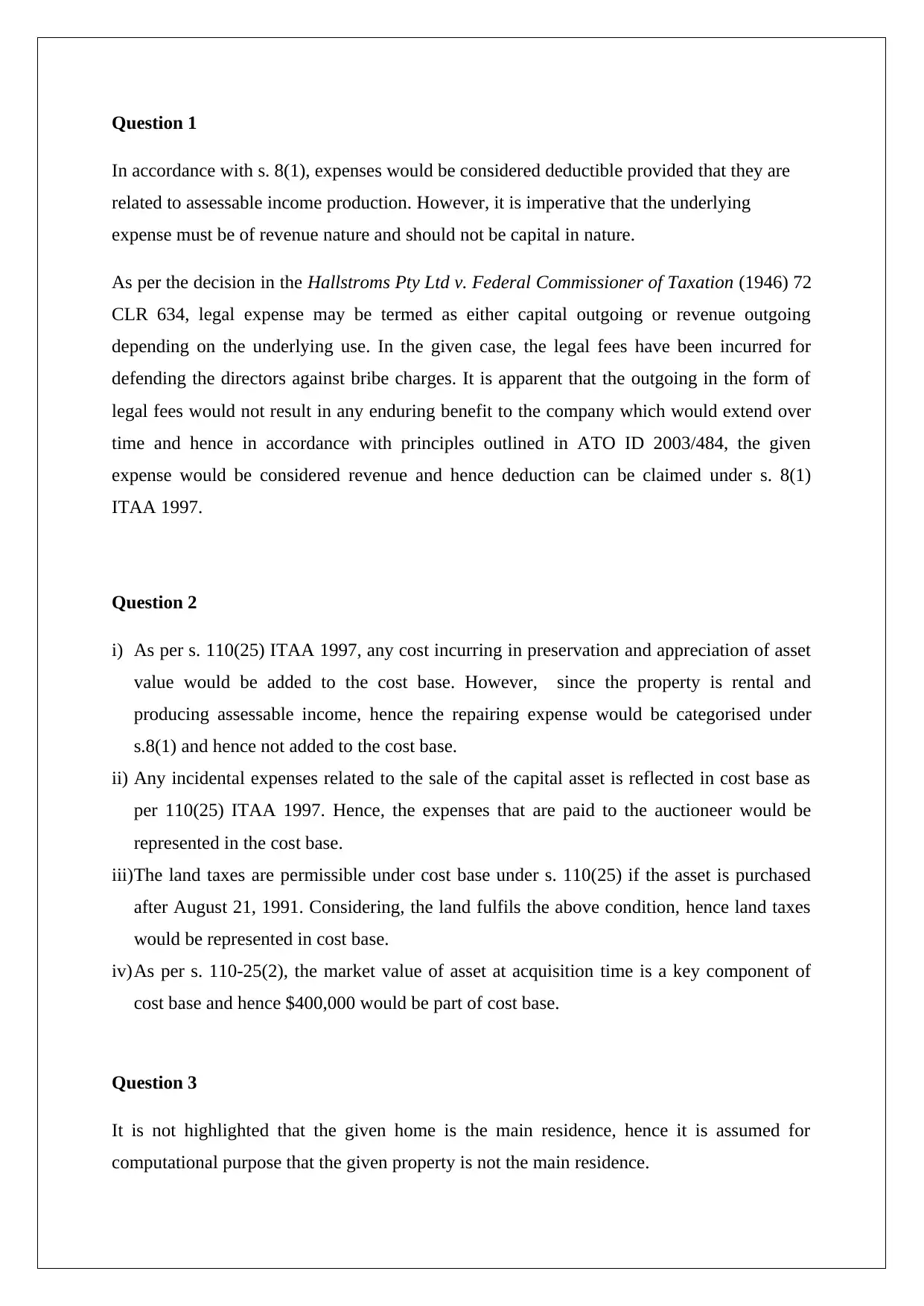
Question 1
In accordance with s. 8(1), expenses would be considered deductible provided that they are
related to assessable income production. However, it is imperative that the underlying
expense must be of revenue nature and should not be capital in nature.
As per the decision in the Hallstroms Pty Ltd v. Federal Commissioner of Taxation (1946) 72
CLR 634, legal expense may be termed as either capital outgoing or revenue outgoing
depending on the underlying use. In the given case, the legal fees have been incurred for
defending the directors against bribe charges. It is apparent that the outgoing in the form of
legal fees would not result in any enduring benefit to the company which would extend over
time and hence in accordance with principles outlined in ATO ID 2003/484, the given
expense would be considered revenue and hence deduction can be claimed under s. 8(1)
ITAA 1997.
Question 2
i) As per s. 110(25) ITAA 1997, any cost incurring in preservation and appreciation of asset
value would be added to the cost base. However, since the property is rental and
producing assessable income, hence the repairing expense would be categorised under
s.8(1) and hence not added to the cost base.
ii) Any incidental expenses related to the sale of the capital asset is reflected in cost base as
per 110(25) ITAA 1997. Hence, the expenses that are paid to the auctioneer would be
represented in the cost base.
iii)The land taxes are permissible under cost base under s. 110(25) if the asset is purchased
after August 21, 1991. Considering, the land fulfils the above condition, hence land taxes
would be represented in cost base.
iv)As per s. 110-25(2), the market value of asset at acquisition time is a key component of
cost base and hence $400,000 would be part of cost base.
Question 3
It is not highlighted that the given home is the main residence, hence it is assumed for
computational purpose that the given property is not the main residence.
In accordance with s. 8(1), expenses would be considered deductible provided that they are
related to assessable income production. However, it is imperative that the underlying
expense must be of revenue nature and should not be capital in nature.
As per the decision in the Hallstroms Pty Ltd v. Federal Commissioner of Taxation (1946) 72
CLR 634, legal expense may be termed as either capital outgoing or revenue outgoing
depending on the underlying use. In the given case, the legal fees have been incurred for
defending the directors against bribe charges. It is apparent that the outgoing in the form of
legal fees would not result in any enduring benefit to the company which would extend over
time and hence in accordance with principles outlined in ATO ID 2003/484, the given
expense would be considered revenue and hence deduction can be claimed under s. 8(1)
ITAA 1997.
Question 2
i) As per s. 110(25) ITAA 1997, any cost incurring in preservation and appreciation of asset
value would be added to the cost base. However, since the property is rental and
producing assessable income, hence the repairing expense would be categorised under
s.8(1) and hence not added to the cost base.
ii) Any incidental expenses related to the sale of the capital asset is reflected in cost base as
per 110(25) ITAA 1997. Hence, the expenses that are paid to the auctioneer would be
represented in the cost base.
iii)The land taxes are permissible under cost base under s. 110(25) if the asset is purchased
after August 21, 1991. Considering, the land fulfils the above condition, hence land taxes
would be represented in cost base.
iv)As per s. 110-25(2), the market value of asset at acquisition time is a key component of
cost base and hence $400,000 would be part of cost base.
Question 3
It is not highlighted that the given home is the main residence, hence it is assumed for
computational purpose that the given property is not the main residence.
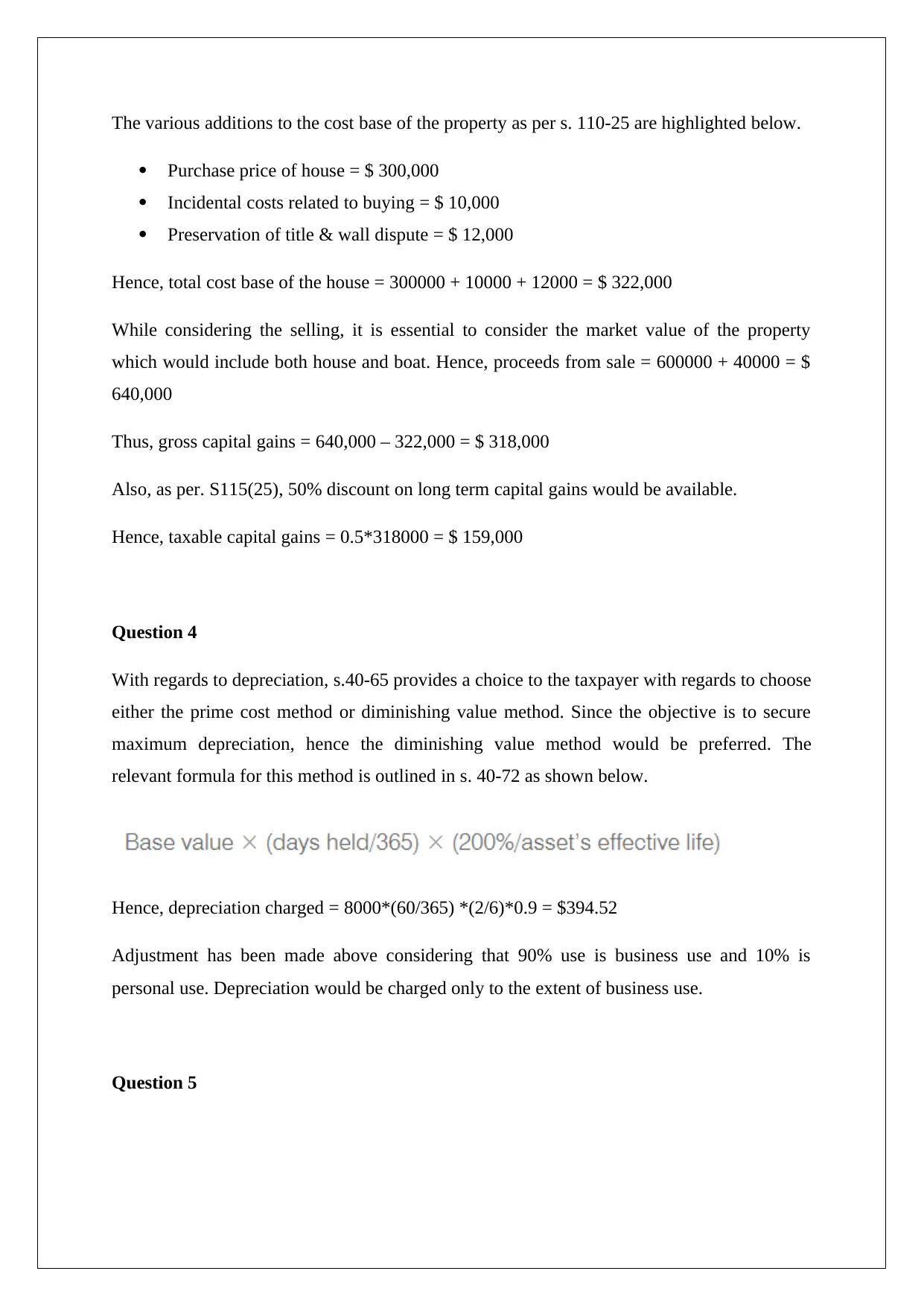
The various additions to the cost base of the property as per s. 110-25 are highlighted below.
Purchase price of house = $ 300,000
Incidental costs related to buying = $ 10,000
Preservation of title & wall dispute = $ 12,000
Hence, total cost base of the house = 300000 + 10000 + 12000 = $ 322,000
While considering the selling, it is essential to consider the market value of the property
which would include both house and boat. Hence, proceeds from sale = 600000 + 40000 = $
640,000
Thus, gross capital gains = 640,000 – 322,000 = $ 318,000
Also, as per. S115(25), 50% discount on long term capital gains would be available.
Hence, taxable capital gains = 0.5*318000 = $ 159,000
Question 4
With regards to depreciation, s.40-65 provides a choice to the taxpayer with regards to choose
either the prime cost method or diminishing value method. Since the objective is to secure
maximum depreciation, hence the diminishing value method would be preferred. The
relevant formula for this method is outlined in s. 40-72 as shown below.
Hence, depreciation charged = 8000*(60/365) *(2/6)*0.9 = $394.52
Adjustment has been made above considering that 90% use is business use and 10% is
personal use. Depreciation would be charged only to the extent of business use.
Question 5
Purchase price of house = $ 300,000
Incidental costs related to buying = $ 10,000
Preservation of title & wall dispute = $ 12,000
Hence, total cost base of the house = 300000 + 10000 + 12000 = $ 322,000
While considering the selling, it is essential to consider the market value of the property
which would include both house and boat. Hence, proceeds from sale = 600000 + 40000 = $
640,000
Thus, gross capital gains = 640,000 – 322,000 = $ 318,000
Also, as per. S115(25), 50% discount on long term capital gains would be available.
Hence, taxable capital gains = 0.5*318000 = $ 159,000
Question 4
With regards to depreciation, s.40-65 provides a choice to the taxpayer with regards to choose
either the prime cost method or diminishing value method. Since the objective is to secure
maximum depreciation, hence the diminishing value method would be preferred. The
relevant formula for this method is outlined in s. 40-72 as shown below.
Hence, depreciation charged = 8000*(60/365) *(2/6)*0.9 = $394.52
Adjustment has been made above considering that 90% use is business use and 10% is
personal use. Depreciation would be charged only to the extent of business use.
Question 5
⊘ This is a preview!⊘
Do you want full access?
Subscribe today to unlock all pages.

Trusted by 1+ million students worldwide
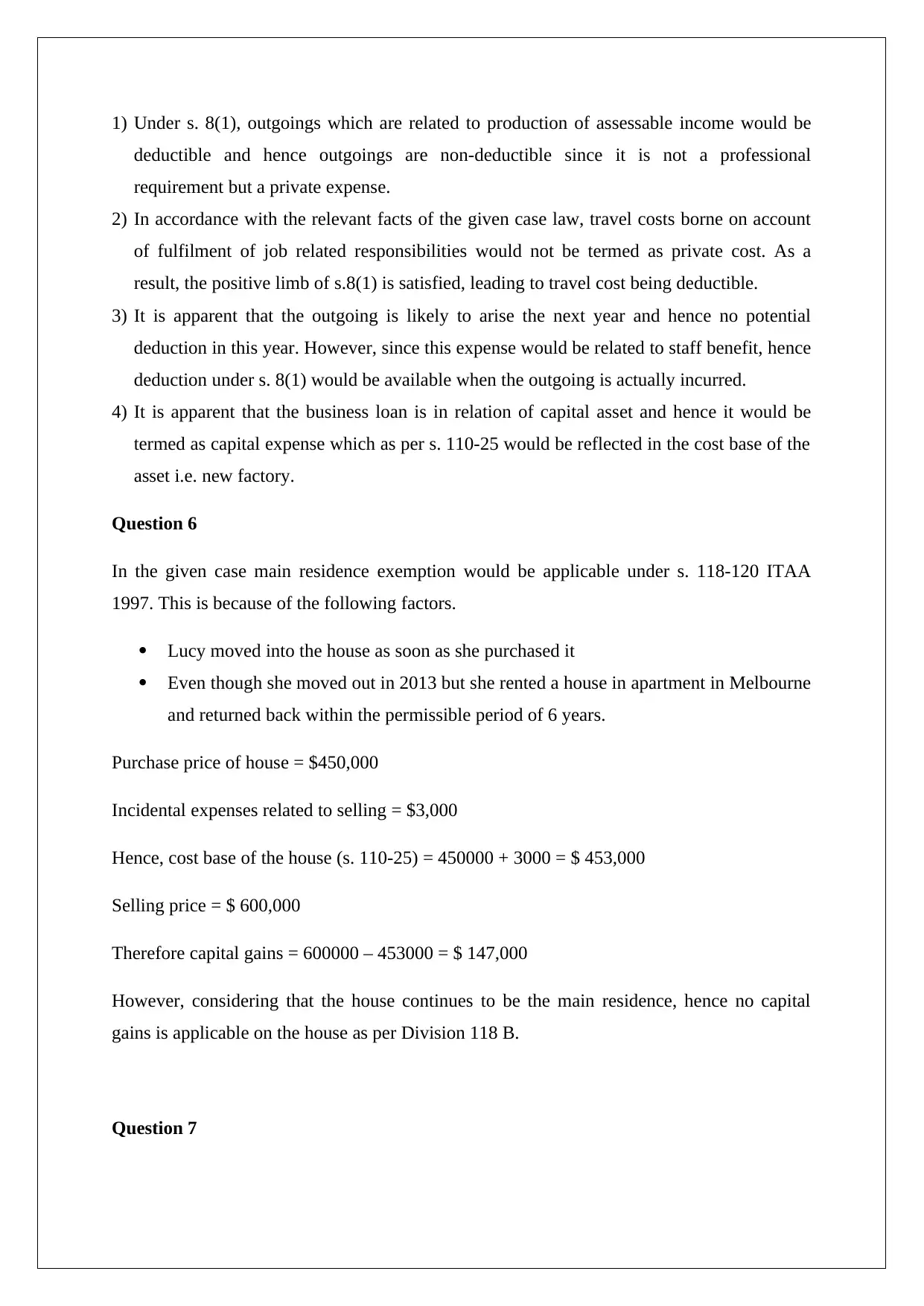
1) Under s. 8(1), outgoings which are related to production of assessable income would be
deductible and hence outgoings are non-deductible since it is not a professional
requirement but a private expense.
2) In accordance with the relevant facts of the given case law, travel costs borne on account
of fulfilment of job related responsibilities would not be termed as private cost. As a
result, the positive limb of s.8(1) is satisfied, leading to travel cost being deductible.
3) It is apparent that the outgoing is likely to arise the next year and hence no potential
deduction in this year. However, since this expense would be related to staff benefit, hence
deduction under s. 8(1) would be available when the outgoing is actually incurred.
4) It is apparent that the business loan is in relation of capital asset and hence it would be
termed as capital expense which as per s. 110-25 would be reflected in the cost base of the
asset i.e. new factory.
Question 6
In the given case main residence exemption would be applicable under s. 118-120 ITAA
1997. This is because of the following factors.
Lucy moved into the house as soon as she purchased it
Even though she moved out in 2013 but she rented a house in apartment in Melbourne
and returned back within the permissible period of 6 years.
Purchase price of house = $450,000
Incidental expenses related to selling = $3,000
Hence, cost base of the house (s. 110-25) = 450000 + 3000 = $ 453,000
Selling price = $ 600,000
Therefore capital gains = 600000 – 453000 = $ 147,000
However, considering that the house continues to be the main residence, hence no capital
gains is applicable on the house as per Division 118 B.
Question 7
deductible and hence outgoings are non-deductible since it is not a professional
requirement but a private expense.
2) In accordance with the relevant facts of the given case law, travel costs borne on account
of fulfilment of job related responsibilities would not be termed as private cost. As a
result, the positive limb of s.8(1) is satisfied, leading to travel cost being deductible.
3) It is apparent that the outgoing is likely to arise the next year and hence no potential
deduction in this year. However, since this expense would be related to staff benefit, hence
deduction under s. 8(1) would be available when the outgoing is actually incurred.
4) It is apparent that the business loan is in relation of capital asset and hence it would be
termed as capital expense which as per s. 110-25 would be reflected in the cost base of the
asset i.e. new factory.
Question 6
In the given case main residence exemption would be applicable under s. 118-120 ITAA
1997. This is because of the following factors.
Lucy moved into the house as soon as she purchased it
Even though she moved out in 2013 but she rented a house in apartment in Melbourne
and returned back within the permissible period of 6 years.
Purchase price of house = $450,000
Incidental expenses related to selling = $3,000
Hence, cost base of the house (s. 110-25) = 450000 + 3000 = $ 453,000
Selling price = $ 600,000
Therefore capital gains = 600000 – 453000 = $ 147,000
However, considering that the house continues to be the main residence, hence no capital
gains is applicable on the house as per Division 118 B.
Question 7
Paraphrase This Document
Need a fresh take? Get an instant paraphrase of this document with our AI Paraphraser
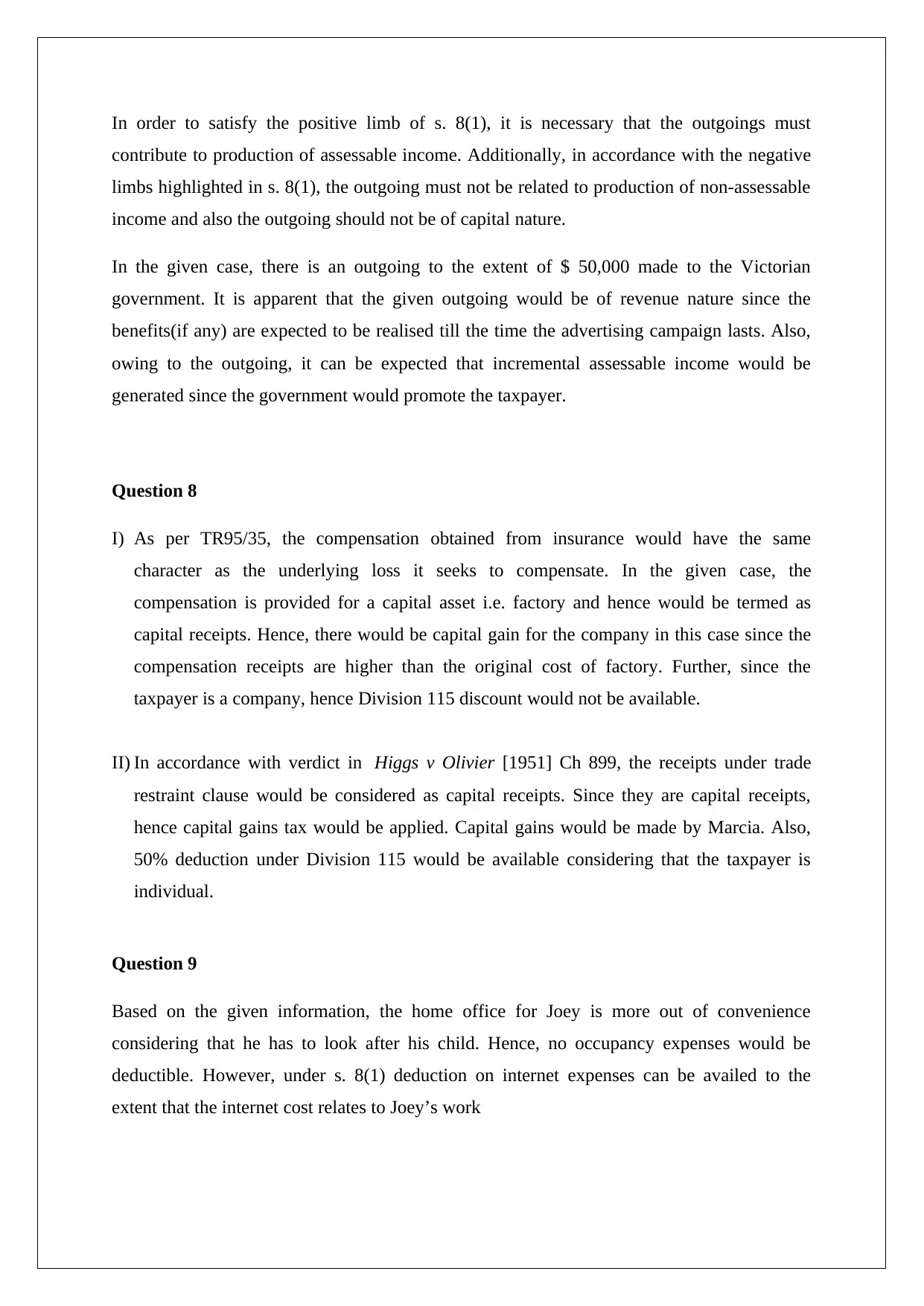
In order to satisfy the positive limb of s. 8(1), it is necessary that the outgoings must
contribute to production of assessable income. Additionally, in accordance with the negative
limbs highlighted in s. 8(1), the outgoing must not be related to production of non-assessable
income and also the outgoing should not be of capital nature.
In the given case, there is an outgoing to the extent of $ 50,000 made to the Victorian
government. It is apparent that the given outgoing would be of revenue nature since the
benefits(if any) are expected to be realised till the time the advertising campaign lasts. Also,
owing to the outgoing, it can be expected that incremental assessable income would be
generated since the government would promote the taxpayer.
Question 8
I) As per TR95/35, the compensation obtained from insurance would have the same
character as the underlying loss it seeks to compensate. In the given case, the
compensation is provided for a capital asset i.e. factory and hence would be termed as
capital receipts. Hence, there would be capital gain for the company in this case since the
compensation receipts are higher than the original cost of factory. Further, since the
taxpayer is a company, hence Division 115 discount would not be available.
II) In accordance with verdict in Higgs v Olivier [1951] Ch 899, the receipts under trade
restraint clause would be considered as capital receipts. Since they are capital receipts,
hence capital gains tax would be applied. Capital gains would be made by Marcia. Also,
50% deduction under Division 115 would be available considering that the taxpayer is
individual.
Question 9
Based on the given information, the home office for Joey is more out of convenience
considering that he has to look after his child. Hence, no occupancy expenses would be
deductible. However, under s. 8(1) deduction on internet expenses can be availed to the
extent that the internet cost relates to Joey’s work
contribute to production of assessable income. Additionally, in accordance with the negative
limbs highlighted in s. 8(1), the outgoing must not be related to production of non-assessable
income and also the outgoing should not be of capital nature.
In the given case, there is an outgoing to the extent of $ 50,000 made to the Victorian
government. It is apparent that the given outgoing would be of revenue nature since the
benefits(if any) are expected to be realised till the time the advertising campaign lasts. Also,
owing to the outgoing, it can be expected that incremental assessable income would be
generated since the government would promote the taxpayer.
Question 8
I) As per TR95/35, the compensation obtained from insurance would have the same
character as the underlying loss it seeks to compensate. In the given case, the
compensation is provided for a capital asset i.e. factory and hence would be termed as
capital receipts. Hence, there would be capital gain for the company in this case since the
compensation receipts are higher than the original cost of factory. Further, since the
taxpayer is a company, hence Division 115 discount would not be available.
II) In accordance with verdict in Higgs v Olivier [1951] Ch 899, the receipts under trade
restraint clause would be considered as capital receipts. Since they are capital receipts,
hence capital gains tax would be applied. Capital gains would be made by Marcia. Also,
50% deduction under Division 115 would be available considering that the taxpayer is
individual.
Question 9
Based on the given information, the home office for Joey is more out of convenience
considering that he has to look after his child. Hence, no occupancy expenses would be
deductible. However, under s. 8(1) deduction on internet expenses can be availed to the
extent that the internet cost relates to Joey’s work

In accordance to s. 25-5 ITAA 1997, deduction can be claimed by taxpayer in relation to any
cost which is related to managing tax affairs. Since the fee paid for income tax return
preparation to the accountant falls within this domain, hence $ 450 would be deductible for
tax.
The interest payments on the mortgage would be reflected in the cost base of the asset in
accordance with s. 110(25) ITAA1997. Even though, there is a home office but it is more
driven by convenience than the need to have a home office, hence deduction for interest
under s. 25(30) ITAA 1997 would not apply here.
Question 10
In accordance with s. 104-135, any capital losses cannot be adjusted against the taxable
income and instead can be only adjusted against capital gains if any.
Capital losses on sale of shares = 50000-25000 = $ 25,000
It is apparent that Steph’s friend has purchased the house in the pre-CGT era considering that
CGT was introduced on September 20,, 1985. Hence, when the asset is passed to Steph, no
CGT implications would arise and also the previous costs are ignored.
Cost base of the house for Steph in accordance with s. 110-25 = $500,000
Sale proceeds from house = $ 700,000
Capital gains on sale of house = 700000 – 500000 = $ 200,000
Please note that main residence exemption under Division 118-B would not apply owing to
Steph not residing in the house and using for rent instead.
Net capital gains = 200000 – 50000 = $ 150,000
After Division 115-B deduction, taxable capital gains = 0.5*150000 = $ 75,000
cost which is related to managing tax affairs. Since the fee paid for income tax return
preparation to the accountant falls within this domain, hence $ 450 would be deductible for
tax.
The interest payments on the mortgage would be reflected in the cost base of the asset in
accordance with s. 110(25) ITAA1997. Even though, there is a home office but it is more
driven by convenience than the need to have a home office, hence deduction for interest
under s. 25(30) ITAA 1997 would not apply here.
Question 10
In accordance with s. 104-135, any capital losses cannot be adjusted against the taxable
income and instead can be only adjusted against capital gains if any.
Capital losses on sale of shares = 50000-25000 = $ 25,000
It is apparent that Steph’s friend has purchased the house in the pre-CGT era considering that
CGT was introduced on September 20,, 1985. Hence, when the asset is passed to Steph, no
CGT implications would arise and also the previous costs are ignored.
Cost base of the house for Steph in accordance with s. 110-25 = $500,000
Sale proceeds from house = $ 700,000
Capital gains on sale of house = 700000 – 500000 = $ 200,000
Please note that main residence exemption under Division 118-B would not apply owing to
Steph not residing in the house and using for rent instead.
Net capital gains = 200000 – 50000 = $ 150,000
After Division 115-B deduction, taxable capital gains = 0.5*150000 = $ 75,000
⊘ This is a preview!⊘
Do you want full access?
Subscribe today to unlock all pages.

Trusted by 1+ million students worldwide
1 out of 6
Related Documents
Your All-in-One AI-Powered Toolkit for Academic Success.
+13062052269
info@desklib.com
Available 24*7 on WhatsApp / Email
![[object Object]](/_next/static/media/star-bottom.7253800d.svg)
Unlock your academic potential
Copyright © 2020–2025 A2Z Services. All Rights Reserved. Developed and managed by ZUCOL.
![Taxation Law: CGT, Deductions, and Exemptions - Student ID [Date]](/_next/image/?url=https%3A%2F%2Fdesklib.com%2Fmedia%2Ftaxation-law-computation-explanations_page_2.jpg&w=256&q=75)




